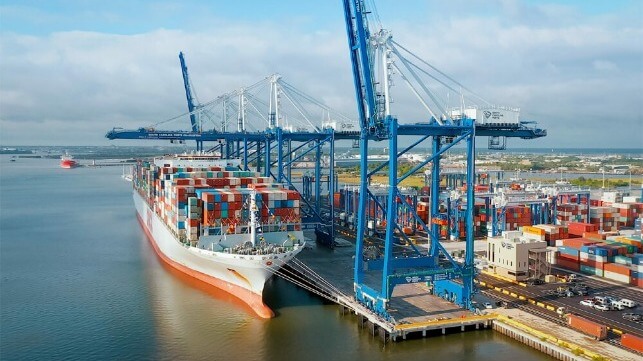Charleston and ILA reach groundbreaking agreement for container transport

South Carolina Ports, the state agency that oversees operations of the state’s ports, and the International Longshoremen’s Association have reached a historic agreement to create a joint workforce after years of litigation. Charleston’s multibillion-dollar new container terminal had sat largely unused due to the dispute, while the settlement also offers a glimmer of hope for the master contract for ports from Maine to the Gulf Coast, which expires Sept. 30.
South Carolina invested in the future of its container operations with the massive Hugh K. Leatherman Terminal, which was completed in early 2021 but found itself in a lengthy legal battle over staffing. For more than 50 years, SC Ports used a so-called hybrid model for its workforce, in which duties were segregated and port employees, not union members, operated cranes and heavy equipment. Despite a 2012 contract amendment requiring that future ports be fully staffed by unions, SC Ports attempted to follow the hybrid model when the new Leatherman Terminal opened.
The state’s governor, Henry McMaster, had vowed to fight the union every step of the way after the dispute began in 2021. The dispute went through a series of courts and was eventually rejected by the U.S. Supreme Court, clearing the way for the ILA to fill Leatherman’s position. SC Ports and the ILA quietly began talks that spanned most of 2024 to resolve the dispute and clear the way for Leatherman to reach full capacity.
“SC Ports and ILA are proud to announce that after productive and cooperative discussions, we have jointly developed and agreed to the framework for an operating agreement that will provide long-term stability and competitiveness to the Port of Charleston while providing an improved product,” ILA and SC Ports said in a joint statement on June 25. “SC Ports and ILA are ready to welcome our USMX partners to the Leatherman Terminal without hesitation for many years to come, now that all obstacles to operations have been removed.”
The Post and Courier newspaper in Charleston reports that the master plan calls for an end to the separation of staff assignments under the old hybrid model. Crane and equipment operators can now join the union or remain part of the SC Ports workforce, and both will handle equipment operations. While the court decision only affected Leatherman, the agreement also covers the older Wando Welch Terminal as well as the smaller North Charleston Terminal, with the new joint model to be applied at all three container facilities.
Port officials told Port and Courier that details still need to be worked out to implement the framework agreement, but they are confident it can move forward quickly. Port officials are calling the agreement a “reopening” of the Hugh K. Leatherman Terminal.
The major shipping companies, represented by the US Maritime Alliance (USMX), had refused to move their operations to the Leatherman Terminal due to the dispute. The state had invested heavily in the construction of the new terminal, which was to create an annual capacity of 700,000 TEU in its first phase. The completed terminal will have three berths and a total annual capacity of 2.4 million TEU, approximately twice the capacity of the Welch Terminal.
The opening of the terminal will facilitate the expansion of operations in Charleston and also relieve pressure on the historic terminal. Recently, SC Ports attempted to close part of the berth at the Welch Terminal for seawall repairs, causing congestion. The port has just announced that it will suspend the construction project to ease the backlog of container ships.
The newspaper report highlights that Savannah is the last major port in the U.S. to adopt the hybrid model, in which union workers move boxes on the ground while port employees operate the cranes and equipment. After negotiating the new contract in Charleston, the ILA is looking to end the model in Savannah as well, as the Georgia Ports Authority plans a new terminal and an expansion of its container operations.
But there are growing fears that a crippling strike at US East Coast ports could occur in October after the ILA recently said it would not resume talks due to local disputes over port automation. USMX and the ILA were due to begin talks this month to resolve the longshoremen’s master contract. Although the union has a history of reaching agreements on new contracts without strikes, it has repeatedly said it will not miss the Sept. 30 deadline.



